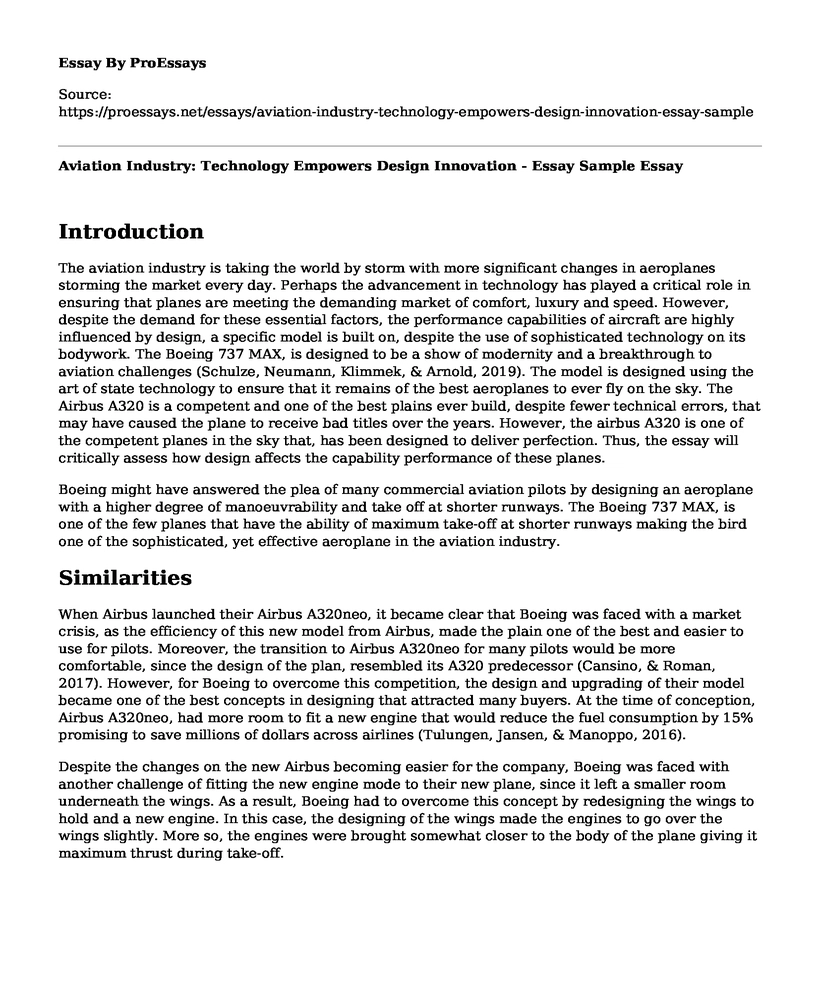Introduction
The aviation industry is taking the world by storm with more significant changes in aeroplanes storming the market every day. Perhaps the advancement in technology has played a critical role in ensuring that planes are meeting the demanding market of comfort, luxury and speed. However, despite the demand for these essential factors, the performance capabilities of aircraft are highly influenced by design, a specific model is built on, despite the use of sophisticated technology on its bodywork. The Boeing 737 MAX, is designed to be a show of modernity and a breakthrough to aviation challenges (Schulze, Neumann, Klimmek, & Arnold, 2019). The model is designed using the art of state technology to ensure that it remains of the best aeroplanes to ever fly on the sky. The Airbus A320 is a competent and one of the best plains ever build, despite fewer technical errors, that may have caused the plane to receive bad titles over the years. However, the airbus A320 is one of the competent planes in the sky that, has been designed to deliver perfection. Thus, the essay will critically assess how design affects the capability performance of these planes.
Boeing might have answered the plea of many commercial aviation pilots by designing an aeroplane with a higher degree of manoeuvrability and take off at shorter runways. The Boeing 737 MAX, is one of the few planes that have the ability of maximum take-off at shorter runways making the bird one of the sophisticated, yet effective aeroplane in the aviation industry.
Similarities
When Airbus launched their Airbus A320neo, it became clear that Boeing was faced with a market crisis, as the efficiency of this new model from Airbus, made the plain one of the best and easier to use for pilots. Moreover, the transition to Airbus A320neo for many pilots would be more comfortable, since the design of the plan, resembled its A320 predecessor (Cansino, & Roman, 2017). However, for Boeing to overcome this competition, the design and upgrading of their model became one of the best concepts in designing that attracted many buyers. At the time of conception, Airbus A320neo, had more room to fit a new engine that would reduce the fuel consumption by 15% promising to save millions of dollars across airlines (Tulungen, Jansen, & Manoppo, 2016).
Despite the changes on the new Airbus becoming easier for the company, Boeing was faced with another challenge of fitting the new engine mode to their new plane, since it left a smaller room underneath the wings. As a result, Boeing had to overcome this concept by redesigning the wings to hold and a new engine. In this case, the designing of the wings made the engines to go over the wings slightly. More so, the engines were brought somewhat closer to the body of the plane giving it maximum thrust during take-off.
Differences
Among one of the notable differences between the two plane models is widely visible on its engine design. Even though Airbus A320neo took no interest in redesigning the engine position on the wings, Boeing 737 MAX, took a more significant leap. However, the performance capability of this model became extremely cumbersome for many pilots, despite have a chance to take off at a shorter runway. The Boeing 737 MAX has one of the most significant limitations during take-off, where the nose tended to point far upwards, posing higher possibilities of a "stall." As a result, the new model poses a significant challenge as the plane was supposed to work like the old model. However, Boeing figured out how to overcome this problem, through the installation of a special software Maneuvering, Characteristics, Augmentation, System (MCAS) to operate the sensors, when the plane's nose fly too high.
Conclusion
In the bottom line, the performance of the two commercial aeroplanes has been widely influenced by design in each plane. As a result, most of the significant changes were concentrated on the improvement in designing a friendly engine that can save fuel consumption, a step that affects the performance of the plane. However, some of the changes in engine mounting have resulted in significant challenges not only to the pilots but also to the airlines and the passengers.
References
Cansino, J. M., & Roman, R. (2017). Energy efficiency improvements in air traffic: The case of Airbus A320 in Spain. Energy Policy, 101, 109-122. doi.org/10.1016/j.enpol.2016.11.027
Schulze, M., Neumann, J., Klimmek, T., & Arnold, J. (2019). Parametric modelling of a long range aircraft under consideration of engine wing integration. https://elib.dlr.de/128059/
Tulungen, B. B., Jansen, F., & Manoppo, M. R. (2016). Perencanaan Pengembangan Bandar Udara Melonguane Kabupaten Kepulauan Talaud Provinsi Sulawesi Utara. Jurnal Sipil Statik, 4(1). https://ejournal.unsrat.ac.id/index.php/jss/article/view/10724
Cite this page
Aviation Industry: Technology Empowers Design Innovation - Essay Sample. (2023, Apr 05). Retrieved from https://proessays.net/essays/aviation-industry-technology-empowers-design-innovation-essay-sample
If you are the original author of this essay and no longer wish to have it published on the ProEssays website, please click below to request its removal:
- A Discussion on the History of Air Traffic Control Essay
- Airplane's Lift Force and Coefficient for an Airfoil Section at Different Angles of Attack
- The Traffic Alert and Collision Avoidance System - Research Paper
- Embracing Long-Term Competition With Boeing: Embraer's Strategic Approach
- Airline Business: Changes in the Global Environment Since 2017 - Essay Sample
- Essay Example on Aviation Market in Birmingham: Challenges and Opportunities
- Boeing: The Global Aircraft Manufacturing Giant - Essay Sample







